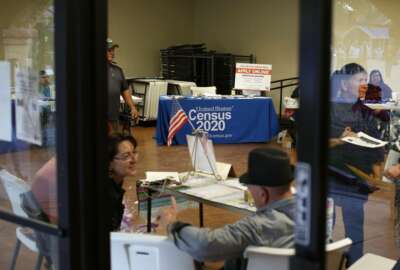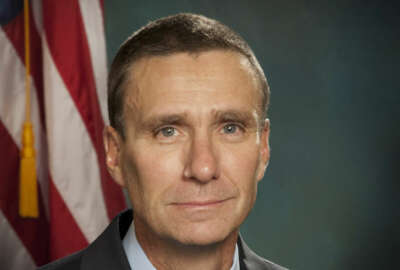
What are the implications of social distancing for 2020 census?
The bureau's public information chief Michael Cook joined Federal Drive with Tom Temin for more information on the implications.
Best listening experience is on Chrome, Firefox or Safari. Subscribe to Federal Drive’s daily audio interviews on Apple Podcasts or PodcastOne.
After working for more than 10 years to reach this very date, the Census Bureau launches the main part of its decennial count just as Americans hunker down and isolate themselves. The bureau’s public information chief Michael Cook joined Federal Drive with Tom Temin for more information on the implications.
Interview transcript:
Tom Temin: Mr. Cook, Good to have you on.
Michael Cook: Thank you. Thanks for having me on your show.
Tom Temin: Could this coronavirus thing have hit at a worse time for the Census Bureau?
Michael Cook: Well, you know, the 2020 census is very resilient in the sense that for the first time ever, everybody has three options or three ways to respond, either on phone, by mail or online. Currently, invitations are hitting mailboxes, and we officially have 6.5 million people who have responded online so far. So we’re happy that, we’re able to have this opportunity to let people know that it’s easy, it’s safe, it’s important, and if you respond yourself, you can do that without coming into contact with any census takers.
Tom Temin: Sure, and that’s good news. I’m looking forward to Friday because I got my Medicare card last Friday, so maybe I’ll get my census mail this Friday? It’ll be two in a row from the federal government. But let me ask about numerators because those that don’t respond or can’t or whatever, by the internet will be in theory touched by an enumerator. How has that hiring gone? And do you have yet all the numerators that the Census Bureau thinks it’ll need?
Michael Cook: We have reached our target of recruiting 2.7 million applicants for those numerators, or census takers, who will be conducting nonresponse follow-up operations later this spring. We’re carefully monitoring the situation and working with the national, state and local health authorities to ensure that all of our field operations is taking into account the safety and the health of our employees, but as well the public. We have adapted some of our field operations to ensure social distancing, as well as postponing or changing some operations currently, which are focused on large groups.
Tom Temin: And of those 2.7 million, those will be winnowed down, I guess, at some point to the numbers you’ll actually need?
Michael Cook: We estimate that we need or may need up to 500,000 census takers to conduct our nonresponse follow-up operation.
Tom Temin: And of course, you’ve got a geographical requirement as well as a sheer number requirement. Do you feel like the places will be covered as well as the total number of enumerators?
Michael Cook: It’s very, very important that we conduct the account precisely, where we count everybody once – only once – in the right place, because the count does reflect the apportionment of seats in the houses of Congress. We are pleased with the applicant pool that we currently have, and we’re going through the process now of vetting those applicants and working towards hiring people to conduct those field operations.
Tom Temin: And with respect to the people that will do the door-to-door, what types of measures, you mentioned that you are taking into account the need for social distancing – a grim phrase if there ever was one. What would they do differently than they would have done had this not happened?
Michael Cook: As we hire these individuals we’re moving our employee training into online versus in class training to ensure that social distancing. We are also taking some steps when it comes to our field work. So, for example, census takers that drop off census invitations in specific areas that don’t receive their mail at a physical address, we’re asking them to ring the doorbell, and then leave those packets behind. We have a contingency plan in place, $2 billion, which enables us to create additional mailers and additional questionnaires to send that information directly to those areas that have been impacted to help and ensure an accurate and complete count. The thousands of partners that have stood up and are trusted voices and communities are invaluable for us to get that word out to those communities that it is important. And that it’s easy and safe to respond to the 2020 census.
Tom Temin: We’re speaking with Michael Cook. He’s chief of the Public Information Office at the Census Bureau. And in the census interactions with those community groups, which is pretty crucial, has that altered because of the virus situation? Do you maybe telecommunicate with them, as opposed to having local meetings?
Michael Cook: Our field staff who has had local meetings in the past, they have pivoted a little bit, and they’re conducting those communications via teleconference and virtual communications. We’re also looking at and adjusting our operations for the 2020 census count to ensure an accurate count as well.
Tom Temin: All right, and I guess Census – backing up a little bit, you’ve actually been at this since January. I mean, the very first count took place up in Alaska, and there was a process of canvassing of addresses – came in ahead of schedule and under budget, which I think was an early, big success for Census. How did that happen?
Michael Cook: This decade, conducting the Census not only … we have found efficiencies in our operations by using technology, but specifically creating a master address file. In decades past, we had to have individuals walk the streets of the country to create that address listing. We actually were able to save money and have efficiencies by conducting in-office address canvassing. So –
Tom Temin: There were data sources that you could use that had already done the canvassing.
Michael Cook: Before we count, we have to know where people live. So, back in 2018 we conducted our in-office address canvassing operation, which allowed us to verify 65% of addresses in the office using satellite imagery. This allowed us to have an operational savings, as we count, and build that address list to get a complete and accurate account.
Tom Temin: Are bureau employees mostly teleworking now?
Michael Cook: Our field staff typically works from home, and or our field offices, and those operations are continuing to happen and to occur. We are, though, listening and following the guidance from national, state and local public health officials to ensure that the safety on the health of the public but also our staff is taken the consideration as we continue to conduct the 2020 census.
Tom Temin: Michael Cook is the chief of the Public Information Office at the Census Bureau. Thanks so much for joining me.
Michael Cook: Thanks for having me, and I encourage everybody to go to 2020census.gov for more information.
Tom Temin: We’ll post this interview at www.federalnewsnetwork.com/FederalDrive. Subscribe to the Federal Drive at Apple Podcasts or Podcastone.
Copyright © 2025 Federal News Network. All rights reserved. This website is not intended for users located within the European Economic Area.



